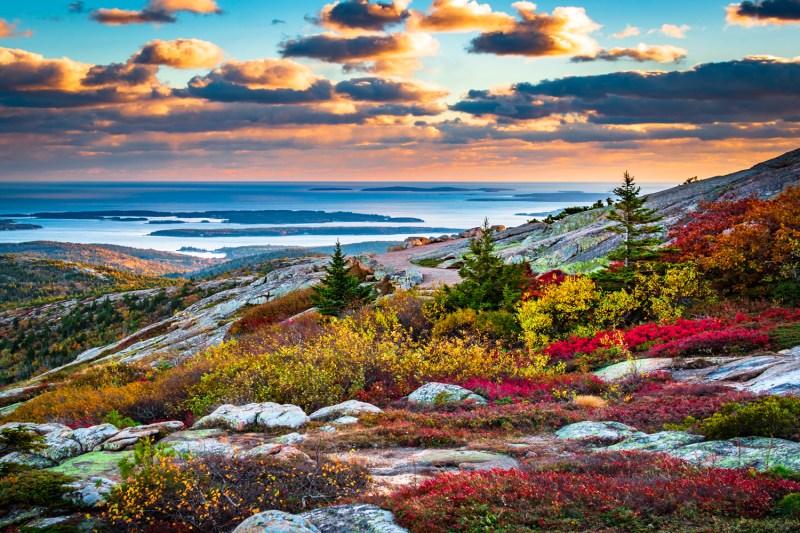
America’s national parks are especially spectacular in the fall. Summer crowds have thinned at many parks, and the cooler weather is ideal for hiking. And, as the days get shorter and temperatures drop, forests from the Rockies to the Great Smoky Mountains burst into a spectacular collage of color, in preparation for winter. Here are just a few of the best hikes for fall so you can admire the dazzling seasonal transition in America’s national parks.
Emerald Lake at Rocky Mountain National Park

At the end of the summer, the beefy ungulates descend from the park’s alpine meadows, gathering at lower elevations — and during the fall mating season, anxious males bugle vociferously in hopes of enticing female companions. For a sampling of the park’s stunning seasonal color, hike Emerald Lake. The 4-mile out-and-back through Tyndall Gorge begins with a ramble through stands of quaking aspen and ponderosa pine and rewards hikers to a photogenic view of Emerald Lake, overshadowed by Flattop Mountain.
Old Rag at Shenandoah National Park

Spread over a 300-square-mile swath of the Blue Ridge Mountains, the diverse woodlands forests of Virginia’s Shenandoah National Park consistently provide a dazzling autumn display. Nearly 95% of the park is covered by mixed hardwood forests, with chestnut and red oak woodlands at higher elevations and woodlands of maple, birch, and yellow poplar spreading downslope. In the fall, the protected area becomes a montage of fiery color, with scarlet red maples, pumpkin-colored black gum, and golden-hued poplars stealing the show.
For a spectacular, bird’s eye view of the vibrant seasonal transition, make a 5.4-mile trek from Berry Hollow to the summit of 3,291-foot Old Rag. The freestanding peak offers 360-degree views, including the park’s string of peaks to the west and the pastoral Virginia piedmont to the east. Post-climb, spend some time exploring Skyline Drive. The 105-mile motorway bisects the national park, providing access to 75 different scenic overlooks, perfect for admiring the park’s seasonal foliage show.
Apgar Lookout at Glacier National Park

For a spectacular glimpse of the park’s fall transition, head for the southwestern portion of the park and hike to the historic Apgar Lookout. The 3.6-mile out-and-back provides a peak-framed view of Lake McDonald from the flanks of Apgar Mountain, with Stanton Mountain, Mount Vaught, and Mount Cannon filling the horizon. For an overnight getaway, the primitive Apgar Campground, the largest in the park, typically stays open through the month of October.
Cadillac Mountain at Acadia National Park

New England is renowned for its stunningly vibrant fall foliage — and Maine’s Acadia National Park is a spectacular place to admire the seasonal transition. Located primarily on Mount Desert Island, the largest island along the coast of Maine, the national park is blanketed with a blend of boreal and deciduous forests — and in autumn, the park’s blueberry bushes blaze red, while beech, maple, and oak trees also add splashes of seasonal color — all juxtaposed against the steely water of the Atlantic Ocean.
For a spectacular view of the park, hike South Ridge Trail to the summit of 1,520 foot Cadillac Mountain, the highest peak along the Eastern Seaboard. The 7.1-mile out-and-back trip offers plenty of panoramic ridgelines — and during the fall, Cadillac Mountain’s expansive summit is also the ideal place to catch migrating birds of prey, including broad-winged hawks, sharp-shinned hawks, and American kestrels. The park’s annual fall Hawk Watch program is even based on top of Cadillac Mountain, along the North Ridge Trail.
Mount Cammerer at Great Smoky Mountains National Park

Shared by North Carolina and Tennessee, the Great Smoky Mountains National Park is the most biodiverse national park in the country — and the park’s rich diversity of flora and fauna includes more than 100 native tree species, making for a spectacular autumn display. The park’s loftiest peaks rise above 6,000 feet, so fall color begins in the higher reaches of the Smokies, and the spreads downslope, with golden hickories, ruby red maples, and fiery scarlet oaks providing a kaleidoscopic seasonal show.
For a taste of the park’s foliage fireworks, make the 11-mile hike from Low Gap to the crest of Mount Cammerer. The 4,298-foot crag is studded with a historic fire tower built in 1939, offering climbers an expansive view of the rippling peaks of the Great Smoky Mountains and Pigeon River Gorge. Post-hike, continue the leaf-peeping with a cruise on the Blue Ridge Parkway. The 469-mile scenic motorway stretches from the Great Smoky Mountains National Park to Virginia’s Shenandoah National Park.



